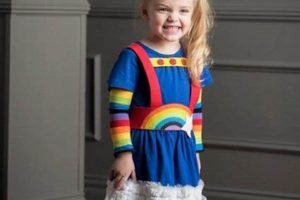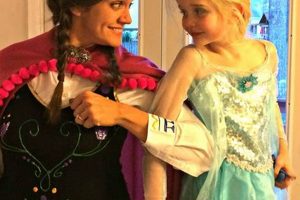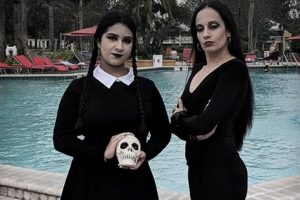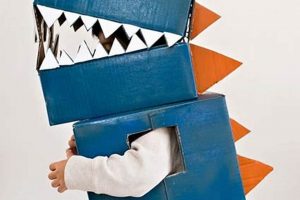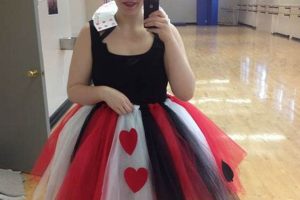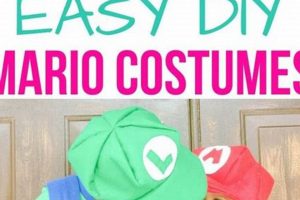Creating a spotted canine-inspired outfit at home involves assembling garments and accessories to emulate the distinctive appearance of a Dalmatian. This activity typically includes crafting or acquiring white clothing and then affixing black spots, either through painting, gluing on felt pieces, or similar methods. For example, an individual might start with a white t-shirt and leggings, adding spots to both before pairing it with dog ears and makeup to complete the impression.
The appeal of such a project resides in its cost-effectiveness and creative control. It allows individuals to tailor the final look to their specific preferences and budgets. Historically, homemade garments and attire have served as economical alternatives to commercially produced options, fostering resourcefulness and ingenuity. This particular application promotes personalized expression and can be a fun activity for families and individuals alike.
The subsequent sections will outline specific techniques and materials suitable for constructing the components needed for a convincing spotted canine-inspired outfit, including guidance on creating realistic spots, selecting appropriate fabrics, and incorporating accessories to enhance the overall effect.
Guidance for Creating a Dalmatian-Inspired Outfit at Home
Constructing a successful spotted canine representation requires careful planning and attention to detail. The following guidance offers suggestions for achieving an effective and recognizable final product.
Tip 1: Spot Size and Placement: Maintain consistent spot sizes and distribute them randomly across the white base garment. Varying spot shapes slightly can enhance the natural appearance. Avoid perfectly symmetrical arrangements.
Tip 2: Fabric Selection: Opt for breathable, comfortable fabrics such as cotton or fleece, particularly if the outfit will be worn for extended periods. The chosen fabric should also be compatible with the method used for applying spots.
Tip 3: Spot Application Methods: Fabric paint provides a durable and long-lasting solution for affixing spots. Alternatively, felt circles can be glued or sewn onto the garment. Consider the washing instructions for each method to ensure longevity.
Tip 4: Ear Construction: Dog ears can be constructed from felt or craft foam. Attach them to a headband or directly to a wig cap. Ensure the ears are securely fastened and appropriately sized for the wearer.
Tip 5: Makeup Considerations: If applying facial makeup, use non-toxic, hypoallergenic products. A simple black nose and subtle spots around the eyes can enhance the overall effect.
Tip 6: Tail Attachment: A tail can be fashioned from fabric and stuffed with batting or fiberfill. Securely attach the tail to the garment using sturdy stitching or safety pins.
Tip 7: Durability and Comfort: Prioritize comfort and durability throughout the construction process. Reinforce seams and attachments to prevent tearing or detachment during wear.
Adherence to these suggestions will contribute to a visually appealing and enduring outcome when developing a spotted canine-inspired representation. Careful planning and execution are crucial for a successful result.
The subsequent section will address potential challenges and offer solutions for common issues encountered during the creation process.
1. Spotting technique
The selection and execution of a spotting technique are critical to the verisimilitude and overall success of a Dalmatian-inspired outfit constructed at home. The chosen method directly influences the costume’s visual appeal, durability, and cost.
- Paint Application Methods
The application of fabric paint offers a durable and washable solution. Techniques include stenciling for consistent shapes, freehand painting for a more organic look, and sponge application for textured spots. The appropriate method depends on the desired aesthetic and the skill level of the individual creating the ensemble. Improper paint application can result in cracking, fading, or uneven coverage, detracting from the costume’s appearance.
- Felt Appliqu Attachment
Felt spots can be glued or sewn onto the base garment. Gluing is a faster method but may compromise washability and long-term adhesion. Sewing provides a more secure attachment, particularly for costumes intended for repeated use. Considerations include the type of adhesive used, the stitch length and type, and the potential for felt shrinkage after washing. Poorly attached felt spots may detach during wear, diminishing the costume’s integrity.
- Spot Size and Distribution
Realistic representation necessitates varying spot sizes and random distribution across the garment. Uniform spots and symmetrical arrangements appear artificial. Templates or guidelines can assist in achieving a natural-looking pattern. The density of spots should be consistent with the Dalmatian breed standard. Improper size and distribution can render the costume unconvincing.
- Fabric Compatibility
The chosen spotting method must be compatible with the base fabric. Certain paints may not adhere well to synthetic materials, while heavy felt can weigh down delicate fabrics. Testing the method on a fabric scrap is recommended before application to the entire garment. Incompatibility can lead to peeling, bleeding, or distortion of the fabric, compromising the costume’s structural integrity.
These facets of spotting technique directly impact the overall quality and realism of the Dalmatian inspired-outfit. Careful consideration of the materials and application methods is essential for achieving a satisfactory and durable result. The effectiveness of the spotting directly influences the recognizability of the costume as representing the Dalmatian breed.
2. Fabric choice
Fabric selection exerts a significant influence on the success of a homemade Dalmatian-inspired outfit. The chosen material affects comfort, durability, and the adherence of applied spots. For instance, selecting a non-breathable synthetic fabric can lead to overheating, rendering the costume impractical for extended wear. Conversely, a durable cotton or fleece provides comfort and allows for effective spot application using paint or felt. The wrong fabric choice can result in an uncomfortable or visually unappealing final product.
Practical considerations dictate specific fabric choices. Lightweight cotton blends are suitable for warmer climates or indoor events, prioritizing breathability. Fleece provides warmth for outdoor activities in cooler temperatures. Stretch fabrics, such as spandex blends, accommodate movement and provide a more form-fitting silhouette. The decision hinges on the intended use of the outfit and environmental conditions. For exa
mple, a parade costume might benefit from a water-resistant outer layer, while a costume for a child’s birthday party prioritizes comfort and ease of movement. The fabric’s texture also impacts the final appearance; a smooth fabric accentuates painted spots, while a textured fabric can add depth to glued-on felt spots.
In summary, appropriate fabric choice is a crucial element in the successful execution of a homemade Dalmatian-inspired outfit. Overlooking this aspect can compromise comfort, durability, and visual appeal. Prioritizing fabric qualities aligned with the intended use and spotting technique is essential for achieving a satisfactory and functional costume. The correct choice contributes directly to the wearer’s enjoyment and the costume’s overall aesthetic impact.
3. Ear construction
The construction of ears is a crucial element in realizing a convincing homemade Dalmatian-inspired outfit. The design and execution of the ears significantly contribute to the costume’s overall recognizability and aesthetic appeal.
- Material Selection
Felt, craft foam, and fabric are commonly employed materials. Felt offers ease of manipulation and affordability. Craft foam provides structure and durability. Fabric allows for customization with patterns and textures. The choice depends on the desired level of realism, budget constraints, and construction skill.
- Shape and Size Proportions
Dalmatian ears are typically floppy and moderately sized. Accurate proportions are essential for conveying the breed’s characteristic appearance. Overly large or small ears can detract from the overall effect. Templates and reference images can assist in achieving realistic proportions.
- Attachment Methods
Ears can be attached to headbands, wig caps, or directly to the wearer’s hair using clips or adhesive. The chosen method must ensure secure and comfortable wear. Headbands offer stability, while wig caps allow for versatile placement. Direct attachment methods require careful consideration of skin safety.
- Structural Reinforcement
Wire or interfacing can provide structural support to maintain the ear’s shape. This is particularly important for larger ears or those made from flexible materials. Reinforcement prevents drooping or distortion, ensuring the ears maintain their intended form throughout wear.
The facets of ear construction collectively influence the final appearance and functionality of the homemade Dalmatian-inspired outfit. Appropriate material selection, proportional accuracy, secure attachment, and structural reinforcement are essential considerations for achieving a visually compelling and comfortable costume. Neglecting these aspects can result in a less convincing or impractical final product.
4. Tail attachment
The secure and appropriate affixation of a tail is a critical element in the successful realization of a homemade Dalmatian-inspired outfit. The tail contributes significantly to the costume’s overall realism and recognizability. The method of attachment must balance aesthetic considerations with practical concerns, ensuring both visual appeal and comfortable wear.
- Attachment Point Selection
The optimal attachment point on the garment is typically the lower back area. This placement mimics the natural tail position of a canine. Factors influencing the selection include the garment’s material, seam strength, and the wearer’s body shape. Reinforcement of the attachment area may be necessary to prevent tearing or distortion. An improperly selected attachment point can result in an unnatural tail position, detracting from the costume’s overall appearance. For instance, attaching the tail too high can resemble an unnatural tail carriage, while attaching it too low can impede movement.
- Attachment Method Durability
Various methods can be employed, including sewing, gluing, and the use of safety pins or hook-and-loop fasteners. Sewing provides the most durable and secure attachment but requires skill and appropriate equipment. Gluing offers a faster alternative but may compromise washability and long-term adhesion. Safety pins and hook-and-loop fasteners offer temporary solutions but may pose safety risks or compromise the costume’s structural integrity. The selected method should withstand the anticipated level of activity and movement. For example, a costume intended for active play requires a more robust attachment method than one designed for static display. Insufficient durability can lead to detachment of the tail during wear, diminishing the costume’s effectiveness.
- Tail Weight Distribution
The weight of the tail must be evenly distributed to prevent discomfort or imbalance. A heavy tail attached to a flimsy garment can cause sagging or pulling. Lightweight stuffing materials, such as fiberfill or batting, are preferable to heavier alternatives. The attachment point should be sufficiently strong to support the tail’s weight without causing strain. Uneven weight distribution can result in discomfort, postural problems, or damage to the costume. For example, a tail that is too heavy or attached poorly can pull the garment out of shape or cause the wearer to experience back pain.
- Concealment of Attachment Mechanism
The attachment mechanism should be concealed to maintain the costume’s aesthetic appeal. Exposed stitching, glue residue, or visible fasteners can detract from the overall impression. Covering the attachment point with fabric or strategically positioning the tail can effectively conceal the mechanism. For instance, carefully sewing the tail directly onto a reinforced seam and then covering the seam with a decorative patch of matching fabric can effectively hide the attachment. Failure to conceal the attachment mechanism can give the costume an unfinished or unprofessional appearance.
The preceding facets of tail attachment are integral to the overall success of a homemade Dalmatian-inspired outfit. Each element contributes to the costume’s visual appeal, durability, and wearer comfort. Neglecting any of these aspects can compromise the costume’s effectiveness and detract from the overall representation of the Dalmatian breed.
5. Makeup application
Makeup application, in the context of a homemade Dalmatian-inspired outfit, constitutes an integral component of achieving a complete and convincing transformation. Strategic use of cosmetics can enhance the costume’s realism, complementing the attire and accessories to fully embody the breed’s distinctive characteristics.
- Nose and Whiskers Definition
The application of black makeup to the nose and the addition of whisker-like markings around the muzzle are crucial for replicating the facial features of a Dalmatian. A matte black cream or liquid liner is typically used to create a darkened nose. Fine, white lines can then be drawn radiating outwards to simulate whiskers. The precision and placement of these features significantly impact the overall impression of a canine visage. For example, an uneve
n or poorly defined nose can detract from the costume’s believability, while well-executed whiskers can enhance the perceived realism. - Spot Augmentation
Makeup can be employed to extend the spotted pattern from the costume onto exposed skin, such as the face, neck, and arms. This creates a seamless transition between the garment and the wearer’s natural features. Small, irregularly shaped black spots can be applied using a sponge or stippling brush and appropriate non-toxic face paint. The size and distribution of these spots should align with those on the clothing to maintain consistency. Incorrect spot size or haphazard placement can disrupt the visual harmony of the costume. If the face make-up is not distributed at the same spot on clothes, this will make the costume less believable.
- Eye Enhancement
Subtle eye makeup can further enhance the canine-inspired look. The application of black eyeliner along the upper lash line can accentuate the eyes and create a more expressive appearance. Alternatively, white eyeliner on the lower waterline can enlarge the eyes and mimic the wide-eyed expression often associated with dogs. Excessive or poorly applied eye makeup, however, can appear unnatural and detract from the overall effect, pulling the focus away from the Dalmatian motif.
- Color Correction and Blending
Makeup can be used to blend the edges of the costume seamlessly with the wearer’s natural skin tone. This can be particularly relevant when using prosthetics or applying makeup to areas with uneven pigmentation. Strategic use of foundation and concealer can create a uniform base, ensuring that the costume appears as a natural extension of the wearer’s body. Failure to blend the makeup effectively can result in harsh lines and an artificial appearance, diminishing the immersive quality of the Dalmatian representation.
These makeup applications, when executed thoughtfully and skillfully, elevate the overall quality of a homemade Dalmatian-inspired outfit. These elements not only enhance visual appeal but also contribute to the wearer’s confident portrayal of the intended character. The application of makeup serves as a crucial final touch, transforming a simple collection of garments into a convincing embodiment of the Dalmatian breed. Strategic makeup is an effective component to any “dalmation diy costume”.
6. Durability focus
A focus on durability is paramount when constructing a homemade Dalmatian-inspired outfit, influencing material selection, construction methods, and the costume’s longevity. A well-constructed, durable outfit withstands repeated wear, cleaning, and the rigors of various activities, maximizing its value and minimizing the need for frequent repairs or replacements.
- Seam Reinforcement
Reinforcing seams, particularly in high-stress areas such as the tail attachment point or along the inseams of pants, is crucial for preventing tearing and extending the lifespan of the garment. This can be achieved through double-stitching, serging, or using seam tape to provide additional support. For instance, a child’s play costume subjected to frequent movement and abrasion requires more robust seam reinforcement than a static display costume.
- Spot Adhesion Integrity
The method used to apply spots, whether paint or glued-on felt, significantly impacts the costume’s durability. Fabric paint should be applied according to the manufacturer’s instructions and heat-set to ensure optimal adhesion. Felt spots should be securely glued with a fabric-specific adhesive or sewn onto the garment to prevent detachment during wear or washing. The failure to ensure proper spot adhesion can result in a patchy or incomplete costume, diminishing its visual appeal.
- Fabric Selection for Resilience
Choosing fabrics known for their durability, such as cotton blends, fleece, or canvas, contributes significantly to the overall lifespan of the outfit. These materials resist tearing, abrasion, and fading, ensuring that the costume maintains its appearance over time. Lightweight or delicate fabrics, while potentially more comfortable, may require additional reinforcement to withstand regular use. The selection of a durable fabric is vital if a “dalmation diy costume” need to be resilient.
- Fastener Strength and Security
Zippers, buttons, snaps, and hook-and-loop fasteners should be of sufficient quality and securely attached to the garment. Weak or poorly attached fasteners can break or detach, rendering the costume unwearable. Reinforcing the fastener attachment points with additional stitching or interfacing ensures that they remain secure even under stress. For example, a heavy tail attached with a flimsy hook-and-loop fastener is likely to detach during active movement, compromising the costume’s integrity.
In conclusion, a focus on durability during the creation of a homemade Dalmatian-inspired outfit translates into a more practical, cost-effective, and enjoyable final product. Addressing seam reinforcement, spot adhesion, fabric selection, and fastener security ensures that the costume withstands the demands of repeated use, maintaining its appearance and functionality over time. Ignoring these considerations can result in a fragile and short-lived outfit, requiring frequent repairs or replacements.
7. Cost-effectiveness
The economic advantage of creating a spotted canine-inspired outfit at home resides in the potential for significant cost savings compared to purchasing a pre-made costume. This approach allows for resourcefulness and creative control over the final product.
- Material Sourcing and Repurposing
Utilizing existing materials or sourcing inexpensive fabrics and craft supplies is central to cost-effective design. Repurposing old clothing, such as a white t-shirt and leggings, minimizes expenditure. Purchasing discounted fabric remnants or utilizing coupons for craft stores further reduces material costs. The capacity to repurpose or acquire inexpensive materials directly correlates with the project’s overall affordability. For instance, a pre-owned white garment costing a few dollars, combined with inexpensive felt scraps for spots, can yield a substantial cost advantage compared to a commercially manufactured costume.
- Labor Investment vs. Purchase Price
Creating a spotted canine-inspired outfit involves a time investment in design, construction, and detailing. While this labor is non-monetary, it represents a trade-off against the higher purchase price of a ready-made costume. The economic viability of the approach hinges on the individual’s ability to allocate time and resources effectively. Individuals skilled in sewing or crafting may find the labor investment less burdensome, whereas those lacking such skills might find the purchase price more appealing. The value assigned to personal time and skill level determines the cost-effectiveness of the project.
- Customization and Longevity
Homemade outfits offer customization options that may not be available in commercially produced costumes. This customization can extend the outfit’s lifespan and versatility. For instance, an outfit tailored for specific measurements or designed with durable materials may outlast a mass-produced alte
rnative. Alterations and repairs are also more easily managed with a homemade outfit, further increasing its longevity. The ability to tailor and maintain the outfit contributes to its long-term cost-effectiveness. - Reusable Components and Accessories
Certain components of a spotted canine-inspired outfit, such as dog ears or makeup, can be reused for other costumes or dress-up occasions. This reusability offsets the initial cost of these accessories and enhances the overall value of the investment. Selecting versatile accessories that can be integrated into multiple ensembles maximizes their utility and reduces the need for future purchases. The strategic selection of reusable components contributes to the economic efficiency of the outfit.
These facets demonstrate that the financial advantages of crafting a spotted canine-inspired outfit at home depend on factors such as material sourcing, labor investment, customization options, and the potential for component reuse. A mindful approach to these considerations can result in a significant reduction in cost compared to purchasing a commercially available alternative, making this project financially prudent for resourceful individuals.
Frequently Asked Questions
The following addresses common inquiries regarding the creation of a homemade Dalmatian-inspired ensemble, providing clarity on various aspects of its design and construction.
Question 1: What type of paint is most suitable for creating spots on fabric?
Fabric paint specifically designed for textiles is recommended. These paints are formulated to adhere permanently to fabric, resist cracking or peeling, and withstand washing. Acrylic paints are generally not suitable, as they can become stiff and brittle after drying.
Question 2: How can the detachment of glued-on felt spots be prevented?
Utilizing a high-quality fabric glue and ensuring proper surface preparation are crucial. The fabric should be clean and free of any coatings that might inhibit adhesion. Additionally, applying pressure to the felt spot during the drying process and avoiding excessive washing can prolong its attachment.
Question 3: What is the recommended method for attaching a tail to a Dalmatian-inspired outfit?
Sewing is the most durable and secure method. The tail should be securely stitched to a reinforced area of the garment, preferably a seam. Alternatively, strong hook-and-loop fasteners can be used, but these may not provide the same level of security as sewing.
Question 4: How can realism be achieved when creating spots on the costume?
Varying spot sizes and distributing them randomly across the garment is essential. Avoid uniform spot sizes and symmetrical arrangements, as these appear artificial. Reference images of actual Dalmatians can assist in creating a more realistic pattern.
Question 5: Are there specific safety considerations when applying makeup to children for a Dalmatian-inspired look?
Yes, only non-toxic, hypoallergenic face paints specifically designed for children should be used. Avoid using permanent markers or other potentially harmful substances. Always perform a patch test on a small area of skin before applying makeup to the entire face.
Question 6: What type of fabric is most comfortable for a Dalmatian-inspired outfit intended for extended wear?
Breathable fabrics such as cotton blends or lightweight fleece are preferable. These materials allow for air circulation and prevent overheating, ensuring comfortable wear for extended periods. Avoid synthetic fabrics that can trap heat and moisture.
The points highlighted above offer practical advice for addressing potential challenges encountered during the development of a Dalmatian-inspired outfit. Adherence to these guidelines enhances both the aesthetic appeal and the overall quality of the final product.
The subsequent section explores creative variations and advanced techniques for enhancing the Dalmatian-inspired outfit.
Conclusion
The preceding exploration of the “dalmation diy costume” has delineated critical factors influencing its successful creation. These elements encompass spotting techniques, fabric considerations, ear and tail construction, appropriate makeup application, and a commitment to durability, along with cost-effective strategies. The careful balancing of these factors contributes to a visually compelling and enduring final product.
The information provided serves as a foundation for constructing a recognizable and personalized Dalmatian-inspired ensemble. Individual skill level, material availability, and desired level of authenticity will inevitably shape the final outcome. Continued experimentation and refinement of techniques are encouraged to achieve optimal results in future iterations of the “dalmation diy costume”.


